Briefly discussed in this post: 14 books (Legacy; Planta Sapiens; The Language of Landscape; Rain; Disgust; On Kindness; The Shadow of the Object; Capitalism and Freedom; The Road to Serfdom; Offshore; You Are Your Best Thing; London Ontario’s Unrepentant Confederates; The Marquise of O—; and Hell-Bent); 5 movies (The Tale of King Crab; Bardo; Gwledd/The Feast; The Pope’s Exorcist and Blue Valentine); and 2 documentaries (Fighting Indians!; and I Will Be Murdered).
BOOKS
1. Methot, Suzanne. Legacy: Trauma, Story, and Indigenous Healing (2021).
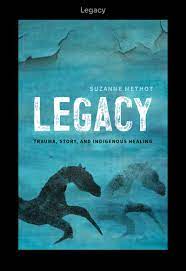
Drawing together Nehiyaw teachings, frontline pedagogy and community development work, trauma theories, history (up to the present moment), contextual analyses, personal and sacred stories, and a strong decolonizing political lens, Suzanne Methot digs deep into the reality and messiness and complexities of what the life-giving and -affirming pursuit of decolonization, healing, care, and wellness looks like not just in theory but in practice, here, now, with these people in all the breadth and depth and richness and pain of being people who refuse to die within a settler colonial State designed to exterminate them. Given the cruelty of the Canadian State and its supporters, and given the ways in which abused people are encouraged to become abusers or simply not taught how to be kind or not afforded the possibility of being kind in order to survive, there is much that is heavy and hard to read hear. Content warning, then, for discussions of violence—and Methot does not shy away from discussing lateral violence and how settler colonial systems and institutions have deliberately and methodically created a self-reinforcing feedback loop of intergenerational violence in many Indigenous communities. However, what she offers is a vision of a realistic and genuinely possible way forward to decolonization, liberation, interconnectedness, and mutual care. It’s a strong book and I recommend reading it.
2. Calvo, Paco with Natalie Lawrence. Planta Sapiens: The New Science of Plant Intelligence (2022).
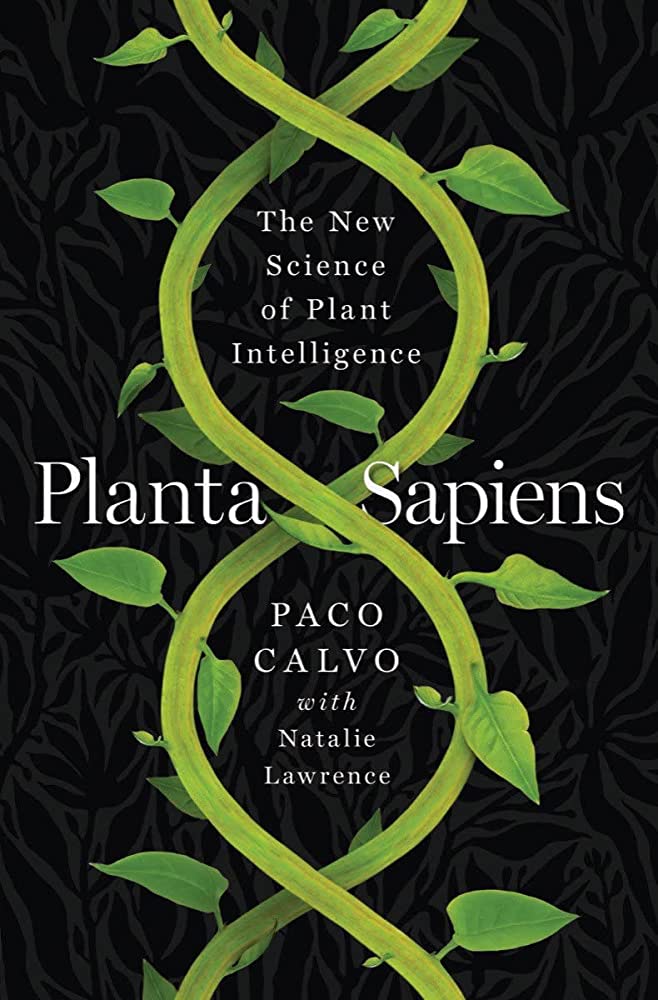
Awhile ago, when I started talking to trees and listening for what they might be saying—you know, when I was looking for ways to go mad that would allow me to continue to be loving and gentle and attentive to others, instead of going made in a way that made me hateful and violent and withdrawn—I began to read various research articles about how plants act based upon memories of the past and expectations of the future, how plants communicate with one another via pheromones and other chemical messages (like a plant warning its neighbours to prepare its defenses because a predatory bug has arrived) or how they share resources with one another through the fungal networks that connect their roots (and thus children trees can keep the stump of their mother tree alive for years and years). I began to understand that plants, too, are a form of intelligent life. It’s just that the epistemological and ontological system I was taught growing up wasn’t one that was well equipped to recognize how diverse intelligent life can be (plants don’t have brains but, it turns out, that doesn’t mean they are incapable of doing things we associate with thinking, choice-making, planning, and agency). Calvo Paco has studied this topic in some detail and in this book, written with Natalie Lawrence, he shares some of his conclusions and how he got to them. It’s full of fascinating details (to pick just one example, humans use their nervous system to transmit bioelectrical messages around the body, but plants use their vascular system to do this). I love this kind of thing. I have a theory that life is a fractal—that it goes all the way down and all the way up, it’s just that we are more easily able to identify that which is akin to us in size and scale but on where we are situated within that fractal. What is organism and what is environment is really just a matter of where you are situated (and if you don’t believe me about that, just ask the bacteria living in your lower intestine what is organism and what is environment). Of course, this animist perspective is one that is intimately familiar to most older, Indigenous ontologies. Europeans are just relearning this now with their most cutting-edge science. Kinda silly of them (I would say it’s kinda cute but for all the real devastation caused by European epistemologies and ontologies over the last couple of centuries). But these developments are super rad to read about now. Give Europeans a few more centuries and I bet they’ll also finally recognize how a lake is a form of intelligent life, and a mountain range, and a universe, and a muon, and a quark.
3. Spirn, Anne Whiston. The Language of Landscape (1998).
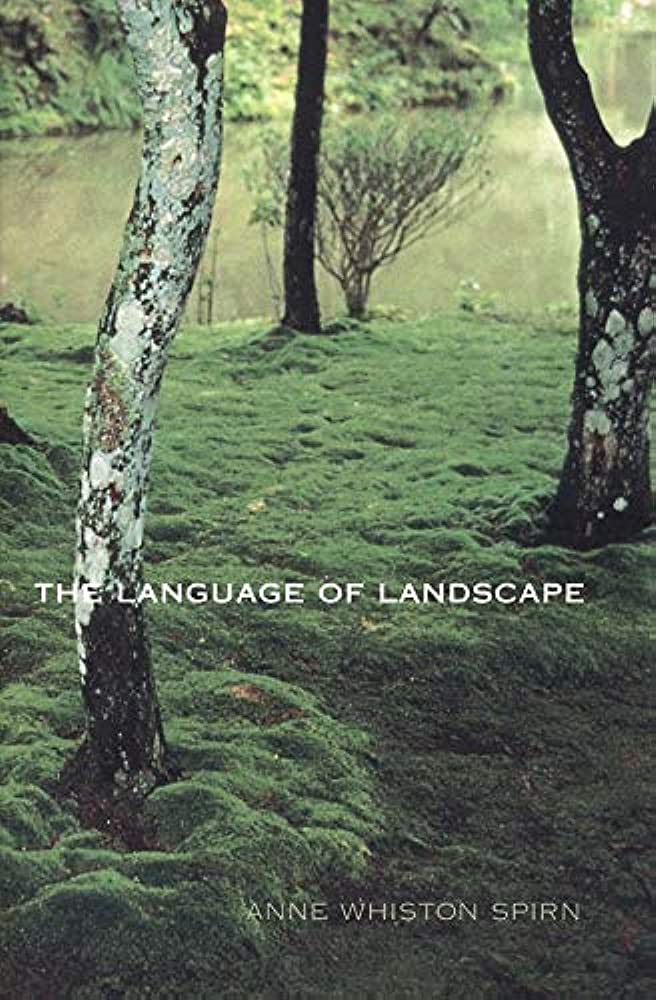
Landscape architects like Anne Whiston Spirn are well-positioned to understand just how fragile and artificial the distinction is between nature and culture when it comes to space and place. You don’t need to read provocateurs like Zizek (who argues that nature is only ideology operating at its purest—since it is the highest aim of ideology to make you think its way of thinking is natural—but who, thereby, removes everything we call “nature” from the domain of the real and positions it in the domain of the imaginary), to understand that organisms and environments are always engaging in mutually-influencing modes of niche construction, and that what at one level is experienced as an organism (say myself at the human level) is also experienced as an environment at another level (say myself at the bacterial level). Niche construction, as ecological developmental evolutionary biologists have pointed out over against Neo-Darwinian fundamentalists, becomes a factor in an organism’s evolution—evolution isn’t only propelled by environmental changes that force organisms to adapt or die. It is also propelled by the fact that organisms change their environments in ways that are guided by their desires, needs, aspirations, and dreams, and those organism-created environmental changes also influence how those organisms evolve. Over time, this doesn’t simply influence the phenotype of an organism (although phenotype changes are a prominent theme in evolutionary sciences), it also influences the soul of a community. If we create cultures that are oriented around greed, people will become greedier over time.
However, landscape architects are particularly attuned to the interconnectedness of things and urge us to consider how the ways in which we shape our communities, spaces, and places, are influenced by those connections, and influence those connections. This is always a local and contextual endeavor, even if continental and global factors (wind currents, temperatures rising, waterways diverted), are also a part of the local and contextual. Consequently, Spirn’s writing is equal parts poetry and pragmatism, dynamic and stable. It’s quite beautiful to read and, having never considered what the world looks like to a landscape architect, I appreciated the opportunity to glimpse the world through her eyes.
4. Barnett, Cynthia. Rain: A Natural and Cultural History (2015).
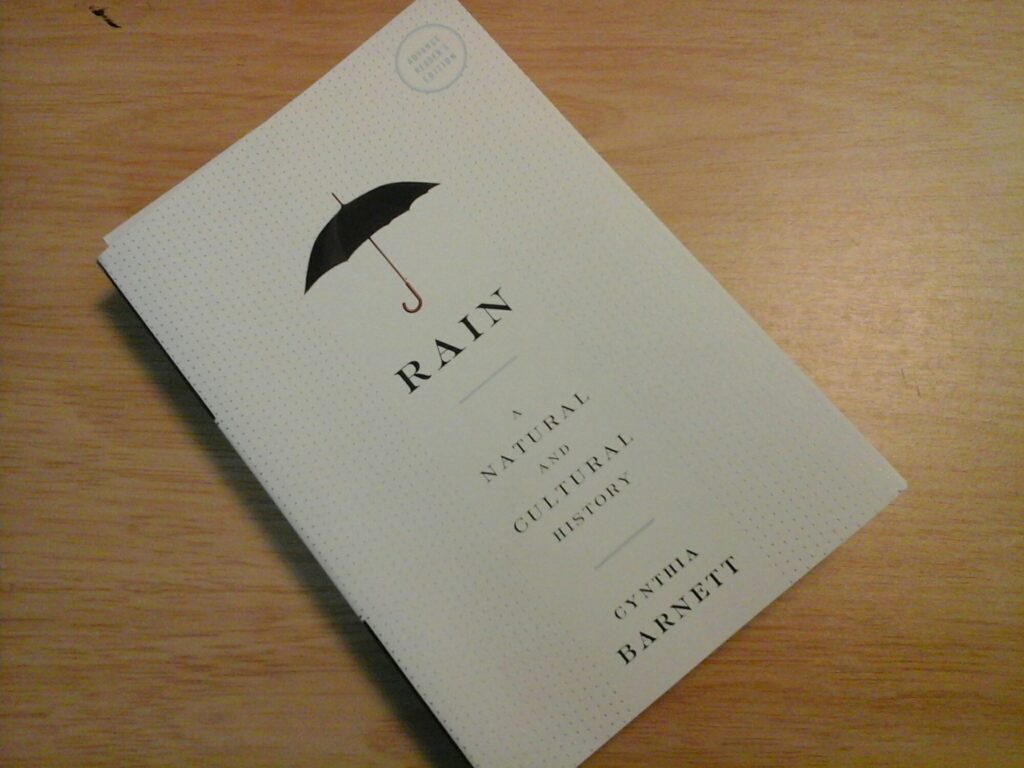
Although there are moments of wonder interspersed into Cynthia Barnett’s book about rain—rain that fell for thousands of years straight when the earth first cooled, rain that was the colour of blood and rubies that fell in India in 2001—the bulk of this book is dedicated to what people have thought or felt about rain over the span of (mostly fairly recent) human history and a few different human cultures. The science was pretty light and the human biographies were pretty ubiquitous. I was hoping for more rain and less stories about people who were into rain. Still, the pages turned quickly and I was happy to finish it so I could move on to something else.
5. Grant, Melanie. Disgust: A Memoir (2021).

Theories related to affect, which kind of blend psychoanalysis, neuroscience, social theory, and gender studies, are some of the most fun and thought-provoking things I have read in recent years. I have found it enriching to think deeply about sadness, anger, joy, fear, excitement, and disgust (and surely desire is intertwined with all of those as well!). Melanie Grant’s memoir on disgust is a short series of meditations on that topic, especially as it pertains to her own life as a lesbian daughter, partner, and mother. Its vibe is actually rather sorrowful (would one want to provoke the feeling of disgust in a book about disgust?). It feels like it’s striving to be something like Maggie Nelson’s Argonauts (and who wouldn’t want to write a book like that?!), but I don’t feel like it gets very close to there.
6. Phillips, Adam and Barbara Taylor. On Kindness (2009).

For much of human history, Adam Phillips and Barbara Taylor argue, the pleasures the self experienced in relation to being kind to others was well known. With the rise of European notions of competitive individualism, social Darwinism, faith in the Hobbesian war of all against all, and neoliberal subjectivities, kindness is replaced by selfishness and the “natural” kindness of children is eviscerated in the process of socialization (and, via Freudian psychoanalysis, much of what was previously considered under the category of kindness is subsumed by the category of sexual desire). As a result, Phillips and Taylor go on to say, we are all robbed of one of the greatest sources of human happiness and of a whole different way of knowing ourselves, others, and the world (for, as they say, “kindness is a way of knowing people beyond our understanding of them”).
Kindness offers us ways of enjoying the company of others without feeling the need to transform others. But Phillips and Taylor are emphatic that it is not exclusive to saints or heroes as some kind of superhuman or magical trait. “Real” kindness, the authors argue (following Winnicot), is kindness that is made possible through experiences of frustration, anger, and even hatred, and is not the supposedly magical kind that is organized to repudiate those feelings. Real kindness comes through in context fraught with ambivalence, and conflict. It is not sentimental. It “sees individuals as they are, rather than how we might want them to be” for “it is kind to care for people just as we find them.”
7. Bollas, Christopher. The Shadow of the Object: Psychoanalysis of the Unthought Known (1987).
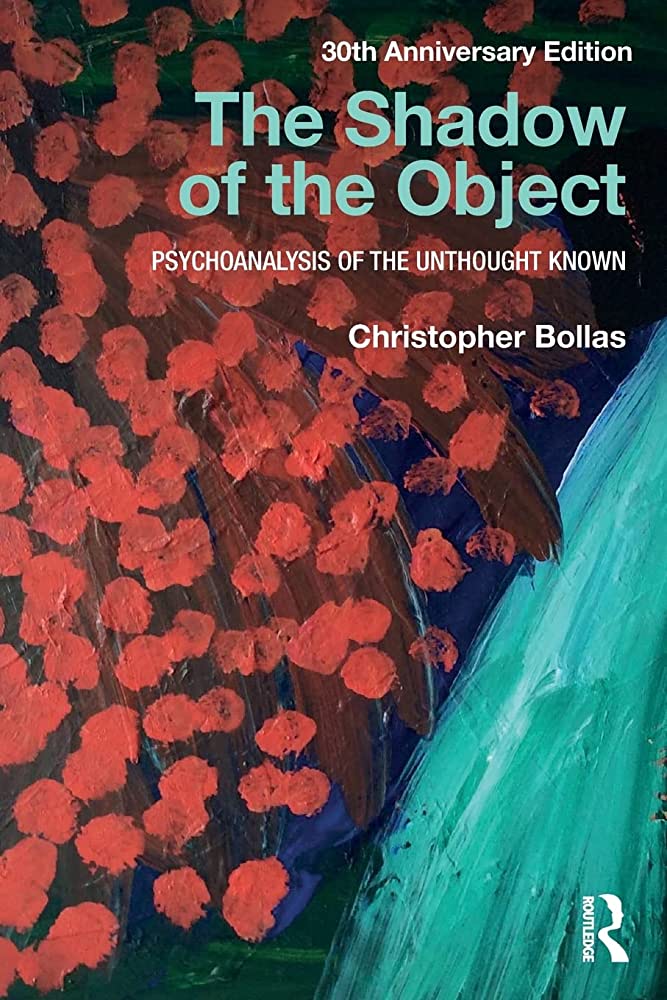
Notes jotted down while reading this exceptionally thought-provoking book. Very highly recommended reading. I’m certainly going to read more of Bollas’s work.
~
Moods, Bollas says, are a way of conserving “something that was but is no longer.” As such, he refers to them as “experience-memories” that preserve a state of being that was linked to the ways we felt while undergoing critical developmental moments.
Bollas focuses on critical moments in our relationships with our parents (especially the mother who, for Bollas following Winnicot, defines the entire environment in which we develop at a very young age: the mother-as-enviornment-and-process). These conserved states of the self can then develop into permanent character traits. It is these self states that we relive when we fall into a mood. In particular, moods can reveal how our self may have become “frozen at a time when self experience was traumatically arrested” especially in relation to parents or to when a child felt that she was losing contact with a parent. Thus, the freezing that occurs, and that manifests via moods, becomes a way to preserve the relationship the child had with the parent at the moment or breakdown (thereby becoming an effort to try and preserve the relationship). Thus, for example, I may no longer have a relationship with my dad but if I fall into a funk and feel sad and helpless and like I’m never good enough, I may be inclined to that kind of moodiness because that’s how I felt when things ended with my dad and, reliving those feelings, becomes a way of feeling like I’m still holding on to or inhabiting a relationship with my dad.
The questions I ask myself then become: why do I incline to certain moods and not others (eg melancholia but not jubilant mania, self-focused anger but not other-focused anger, etc., etc)? What shaped my perhaps subconscious choices about moodiness? When did these moods first develop in me? What part of myself am I reliving when I experience those moods? What am I holding onto with those moods? Asking these questions bring the “unthought knowns” of our moods into the domain of thought knows and thus offer the possibility of transformation in relation to ourselves and others.
~
I read Bollas’s theory on something he refers to as “extractive introjection” Sounds funky—what is it? Bollas builds this idea on the way in which Kleinian psychoanalysts talk about “projective identification.” This refers to when someone tries to get rid of a part of their psychic life but putting it into something else. For example, a father’s may feel guilty about impulse shopping and so, when he sees his child engaging in ordinary impulsiveness he harshly criticizes the child—which, of course, often makes the child want to act in more impulsive ways. Thus, the father guilt around impulsiveness is projected into the child and it is the child who now carries this.
So, okay, that’s “projective identification.” Extractive introjection, according Bollas, is kind of like the reverse of this. Extractive introjection “occurs when one person steals for a certain period of time (from a few seconds or minutes, to a lifetime) an element of another individual’s psychic life. Bollas offers the following illustrative example: a five-year-old child spills a glass of milk. The father yells, “You stupid idiot, why don’t you watch what you’re doing!” However, in the fraction of a second before the father yelled this, the child already felt shocked by their mistake and had become angry with themself. But the father’s remarks, steals from the child the child’s expression of shock, self-criticism, and reparation to the group—in fact, the child is likely stunned that the father, by speaking as he did, assumed that the child is not upset or wishing to repair the damage caused by their accident. Thus, the extractive introjection engaged in by the father steals shock, criticism, and reparation from the child. Consequently, Bollas argues, “[t]he victim of extractive introjection will feel denuded of parts of the self” and he goes on to state that, “[w]hen this occurs in childhood the victim will not have a clear idea why certain elements of mental life seem not to be his [sic] by right.” Indeed, if a child is continually exposed to the type of situation described in the example here, and has their “affective process” stolen, instead of moving through an emotional sequence that moves rapidly from surprise to sorrow to guilt to responsibility to reparation, the child often develops the following emotion sequence: surprise, acute anxiety and fear, humiliation, concealment, and dread.
In fact, as this illustrates, extractive introjection and projective identification frequently go hand-in-hand. As Bollas says: “As a person takes from another person’s psyche, he leaves a gap, or a vacuum, in its place. There he deposits despair or emptiness in exchange for what he has stolen.” Thus, an abuser may engage in an act of extractive introjection and steal something good from us, while then also engaging in an act of projective identification and leave something nasty in us. Which is why, for example, abusers often sleep untroubled at night, while those who are abused toss and turn because they are wracked with guilt. When this is thoroughgoing, or experienced by children as critical early developmental stages, it can result not only in the “loss of a part of the self… but also a loss of one’s sense of one’s own person.”
Reading this makes me ask myself: when have I encountered others who wanted to steal parts of myself and who actually did so (at least in part) when I was vulnerable to them? When they took from me, what did they leave behind in me? I think my dad stole my innocence when I was a child. He took it and has, to this day, maintained his innocence in relation to all the abuse he inflicted on me, my brothers, and my mom. And in place of my innocence, I think he left me with his guilt. Which is why, as a child and teen, I always felt guilty for everything and blamed myself for “ruining my family and breaking my mother’s heart” when my parents made me homeless. That’s an example I have already worked through (and having been able to identify it and name it, I have also been able to expel what was left in me—the guilt—and reclaim what was stolen—my childhood innocence). But there are other moments as well and, it seems to me, those who are intent in taking from us, always seem to draw closer to us at times when we are already feeling weary, vulnerable, uncertain, or lost.
So that leads to another question: how do I ensure that I am not engaging in acts of stealing, especially from vulnerable people (my kids, the folx I try to support at work, others like partners, family, or friends), and how do I, instead, up them guard, nourish, and revel within their own selves? Further, how do I ensure I’m not leaving parts of my psychic self that I don’t want to carry in others? In other words, how do I engage with others that encourages them to celebrate their own specialness, as their own specialness (and not mine or anyone else’s), while also ensuring that my own struggles or woes do not get passed on to them?
Anyway, I thought I would share these because we literally were just talking about this. Hope you also find these ideas useful or fun to think with!
~
Finished reading the Bollas book. Building on his earlier remarks about “projective identification” (when someone, for example, a parent, puts part of themself that they do not like or desire into someone else, like their child), Bollas says the following:
“If the mother or father projectively identifies the element of grief into the child by isolating any sign of sadness as a major psychic occasion, biasing the child to be the family bearer of loss, how will the child know this? … Containing the other’s projective identification seems life defining; grief… feels like this essence of [the child’s] person; it is not thought – it cannot be: it is lived.”
8. Friedman, Milton. Capitalism & Freedom (1965 [1962]).
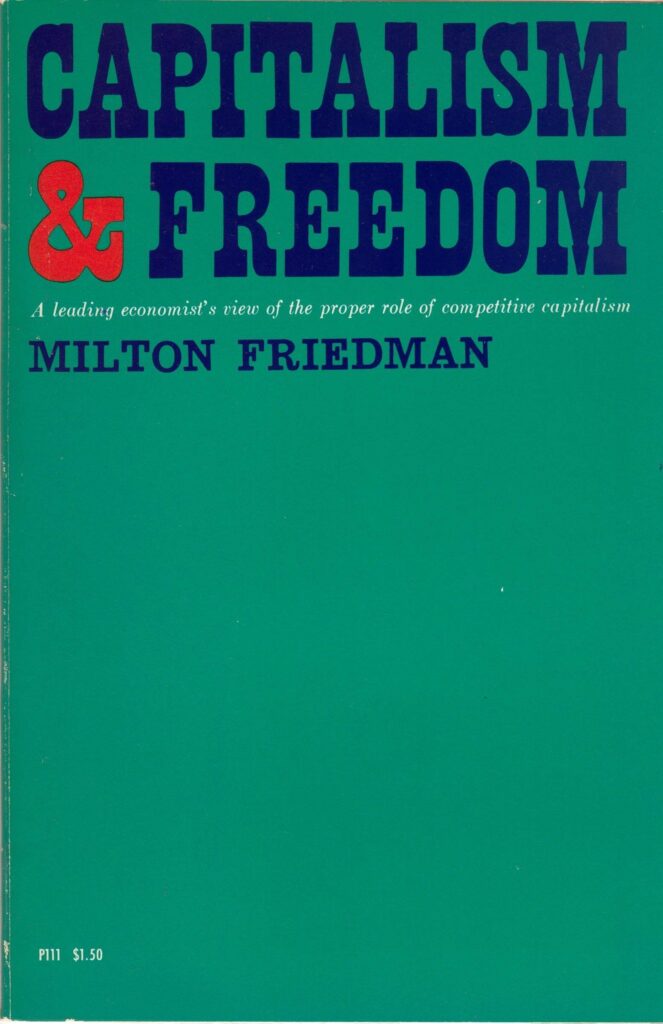
Milton Friedman and Friedrich Hayek are basically the Tweedledee and Tweedledum of neoliberalism (which makes Gary Becker the Red Queen, I suppose). To apply a description first applied to Jordan Peterson, they are what stupid people mistake for smart men. However, given that I am writing on neoliberalism and how its broader dynamics and themes relate to local politics, charity, and resistance, I found myself rereading these knobs. They’re even stupider than I remember them being. Twenty years ago, I would have considered them dangerous but, at least, intelligent. Now, I think they’re just dangerous and stupid. Take, for example, Friedman’s defense of the fact that free market capitalism produces winners and losers. This is a necessity, he asserts, because to make sure that all people win, actually spoils the fun of the game. Or, as he says, using the example of a lottery:
Consider a group of individuals who initially have equal endowments and who all agree voluntarily to enter a lottery with very unequal prizes… Redistribution of the income after the event is equivalent to denying them the opportunity to enter the lottery… Indeed, this is one way to interpret governmental measures to redistribute income through progressive taxes… taxes are imposed after it is already largely known who have drawn the prizes and who the blanks in the lottery of life, and the taxes are voted mostly by those who think they have drawn the blanks.
In this way, Friedman justifies all the inequalities that are fundamental to racial capitalism, settler colonialism, and basically any kind of structural violence and oppression. It’s an utterly absurd argument and yet people take this sort of nonsense seriously. The fact of the matter is that people do not have equal endowments or opportunity, people do not voluntarily and knowingly consent to being on the shit-end of hundreds of years of oppression and violence, and winners and losers are not created through a playful game of chance but through a system that clearly favours some while actively harming others. Anyway, I could go on and on here, but I’ll save that for a different writing project. Suffice to say, fuck this guy and anyone who thinks he’s onto something.
9. Hayek, Friedrich A. The Road to Serfdom (1994 [1944]).
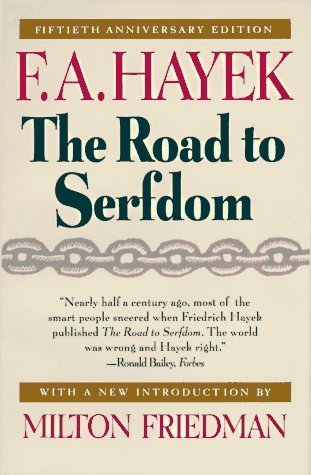
Hayek, who coined the term “Social Justice Warrior,” was convinced that if people really cared deeply about one another, we would end up in Hitler’s Germany. I’m not kidding. Do you love your neighbour? Do you want them to have what they need in order to live the kind of life we all hope to live? Do you feel like we may need to address structural injustices and oppressive power dynamics in order to arrive at collective thriving? If you said “yes” in response to any of these questions, according to Hayek, you’re probably a Nazi. I wish I was exaggerating here, but I’m not. Fuuuuuuuuuck.
10. Peck, Jamie. Offshore: Exploring the Worlds of Global Outsourcing (2017).

Offshoring is complicated. A process that is never done. An entire industry ebbing and flowing, swelling and discharging, distributing more and more wealth amongst fewer and fewer people. A race to the bottom. Always about reducing the number of workers required and the pay received by workers. Mobile, dynamic, unrewarding (except financially), offshoring wanders the world like a plague, bringing false promises, blood-sucking vampires, and entire civilizations based on greed and exploitation everywhere it goes. Even though its complicated. As Jamie Peck demonstrates. It’s here to stay for as long as capitalism persists. Although “here” is increasingly anywhere at all but nowhere for too long. We’re fucked and getting fuckeder every day. But, don’t worry, the more jobs are broken down into their component parts, and the more technology advances, the less need corporations will have for low-paid, deskilled workers. Impoverished workers of the world, rejoice! You have nothing to lose but your lives (which are being taken from you daily anyway).
11. Burke, Tarana and Brené Brown (eds.). You Are Your Best Things: Vulnerability, Shame Resilience, and the Black Experience (2021).
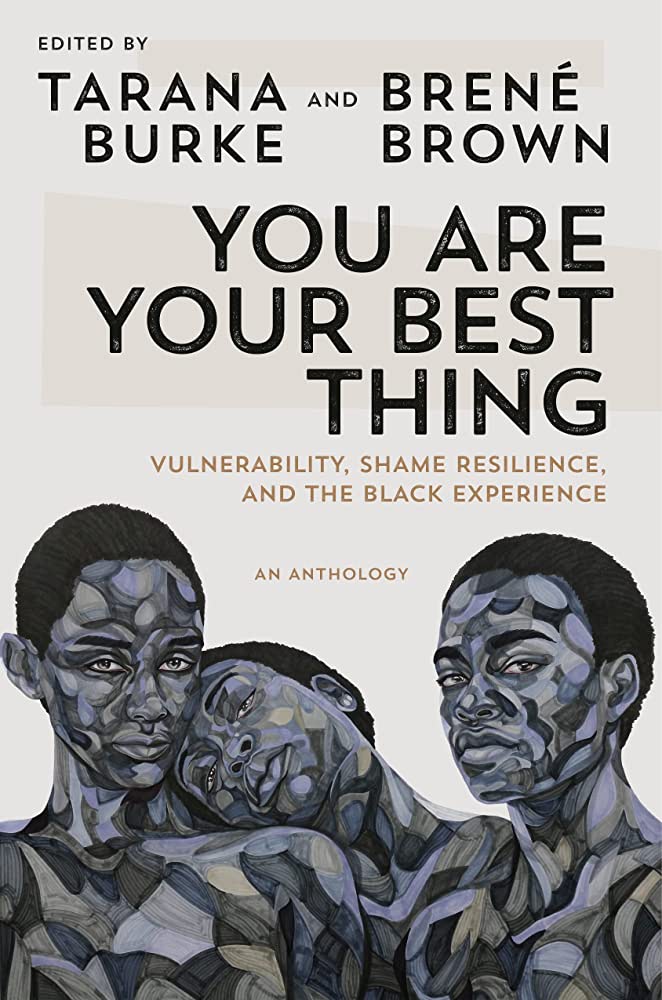
Brené Brown has done a lot of highly-praised work on the themes of shame and resilience but has been rightly criticized for centering the experiences of middle- or upper-class White women. She is much loved by lady bosses, from Hillary Clinton to Executive Directors at local social services. Given the ways in which policing and social work go hand-in-hand, I have often said that if the cops are anti-anti-fascists, then Brené Brown’s analysis is anti-anti-oppression. Enter Tarana Burke (a or the key founder of the #metoo movement) and the 20 other Black writers who contribute to this volume on themes Brown has popularized from anti-racist, anti-White supremacist, Black perspectives. Burke has obviously built up some kind of friendship with Brown and, I think, is offering a very kind-hearted rejoinder and sustained correction to Brown and her legions of business-class White feminists with this volume. It’s a solid piece of work although, as with any collection featuring essays from a wide range of contributors, some pieces are stronger than others.
12. Shaw. Ron W. London Ontario’s Unrepentant Confederates: The Ku Klux Klan and Rendition on Wellington Street (2018).

As I’ve dug into the history of London, Ontario, it’s very public, popular and aggressive embodiment of White supremacy has really stood out (something often remarked upon by BIPOC folx in London—see, for example, Eternity Martis’s memoir, They Said This Would be Fun: Race, Campus Life, and Growing Up—and sometimes picked up by local media). In the 1920s, the KKK was very active locally (not only London but also very active in the region, from Goderich to St. Thomas to Stratford to Dorchester and elsewhere). In the 1990s, neo-Nazis became quite public and active at the same time as a White Supremacist professor was teaching pseudo-science about race as a tenured professor at the local University (a Jordan Peterson of the ‘90s). Then, after ARA and others helped bash the Nazis back underground, various other White supremacy-oriented groups have gained followings here—from Proud Boys and Men’s Rights Activists, to PEGIDA protesters, anti-vaxxers, freedom convoy folks, and even some Three Percenters. There is no doubt that Canada is a White supremacist nation but certain regions embody that more openly and wear it as a badge of pride. The London area is one of those regions.
What I didn’t know, under I read Ron Shaw’s book, was how deeply-rooted London’s White supremacist connections were to violent White supremacy in the American South since the time of the American civil war. Prior to the civil war, wealthy southerners would vacation in the Niagara region where they would meet and network with the White elite social and business classes from southwestern Ontario. Consequently, when the South lost the war, a number of high-ranking Confederate army officers and wealth plantation owners relocated to London. Then, in the aftermath of the war, when the American federal government cracked down to the first rising of the KKK, some prominent KKK members—rich, White men, who had murdered, raped, tortured, robbed, and burned their way through Black communities, also relocated to London with their families. So, yeah, no wonder this place is so racist. London’s roots in overt, violent, smug and sneering White supremacy actually go back much further than I knew. No wonder, then, that it was in London in 2021 that a young White man, wearing body armor and a shirt with a cross on it, used his truck to deliberately ran over and killed four members of the Afzeel family (a fifth member of the family, a nine year old boy, was seriously injured but survived the terrorist attack).
13. Von Kleist, Heinrich. The Marquise of O— And Other Stories (1978 [c.1807]).

Kleist is one of the most well-known, tragic figures of German romanticism. His willingness to follow through on a suicide pact with his terminally-ill lover, Henriette Vogel (she was 34, he was 31), elevated him to the status of a real-life version of Goethe’s Werther mixed with Shakespeare’s Romeo. Consequently, his writing, which was overlooked while he was alive, gained a great deal of posthumous fame. Consequently, he ended up having a significant impact upon some of the big names of pre-World War Two modern German literature whom I have enjoyed (Rilke, Hesse, Musil, Döblin, Walser, Keun, and Broch). And this is what led me to his stories. Having not read m(any?) short stories from this era, and having read a lot of the hella long novels that followed in mid-nineteenth century Europe, I was surprised by the smoothness of their composition and the ease with which they flow. Although I consider myself a romantic, I don’t really jive with this form of romanticism so I wasn’t sure what to expect content-wise but, hey, I found them entertaining enough. Especially in comparison to other cultural artifacts I have read simply because they were said to be an important contribution to, um, something or other.
14. Lorr, Benjamin. Hell-Bent: Obsession, Pain, and the Search for Something like Transcendence in Competitive Yoga (2012).
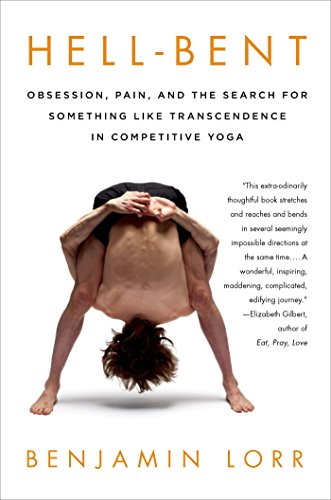
Before Eva Orner’s documentary about Bikram Choudhary’s long history of sexually assaulting women who came to him seeking care, support, and spiritual guidance dropped on Netflix (Bikram: Yogi, Guru, Predator [2019]), Benjamin Lorr took a deep-dive into the world of competitive yogi that was (and is?) a part of the Bikram yoga scene. It’s an intimate insider’s look at the Bikram Yoga scene that tries to navigate the complexity of recognizing that this form of yoga has had a profoundly life-changing affect on many people, while also recognizing that maybe this form of yoga is also making a lot of people even more fucked up than they were before. Abuse is certainly present, especially in relation to Lorr’s comments on Bikram but, knowing what we all know now, I also feel that Lorr deliberately avoids addressing some of the more brutal forms of violence that he must of known, heard about, or witnessed. Hell-Bent is definitely a page-turner but not an altogether satisfactory one.
MOVIES
1. Zoppis, Matteo, and Alessio Rigo de Righi. The Tale of King Crab (2022).
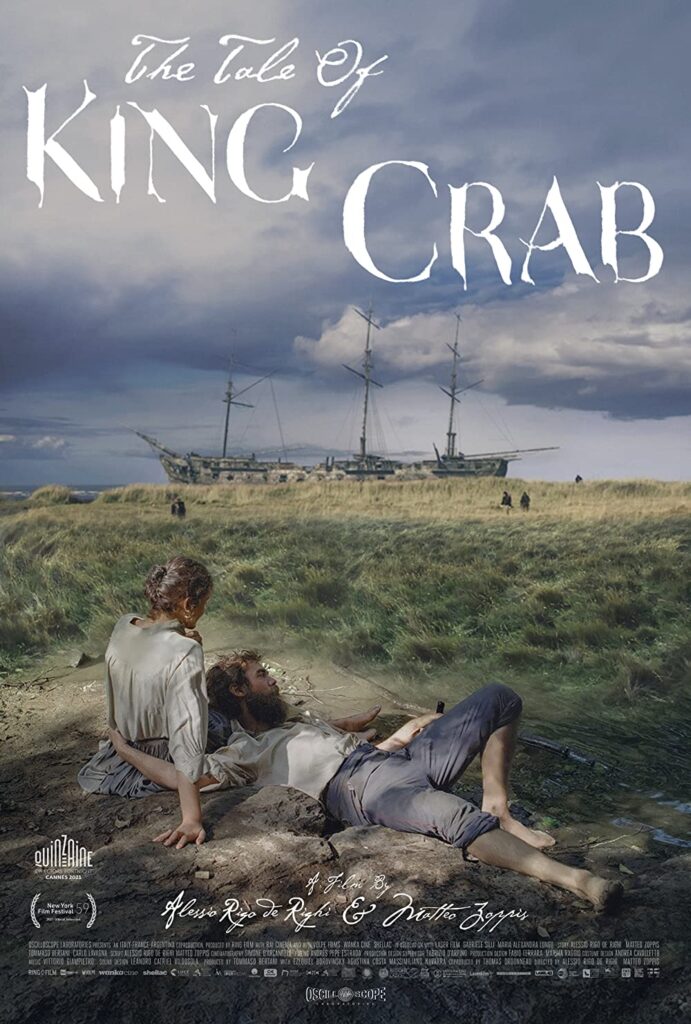
Few people are as enamoured with the figure of the rugged, lonesome, drunken, rebellious, a little bit reckless and a whole lot tragic, straight man, as other straight men. Movies focused on characters like this are very much like rom-coms for cishet men. Don’t we all (straight men, that is), in our loneliness, like to view ourselves as rugged, rebellious, reckless, and tragic and, whether our flaws manifest themselves in drinking or other things (I’m sure there are plenty of options to pick from), don’t we all like to think that one day we could be the protagonist in a movie about ourselves? Isn’t that how we already view ourselves?
I was thinking about this while watching de Zoppis’s and de Righi’s movie about a rugged, lonesome, drunking, rebellious, a little bit reckless and a whole lot tragic, straight man. It’s a artfully-done film with a few delightful moments (like watching a crab climb through the Patagonian mountains in search of a lake supposedly filled with treasures), but mostly it left me feeling pretty flat. Maybe a good option for a guys’ night movie, though, especially if you and your guy friends are indie bros like Kristen Roupenian’s “Cat Person.”
2. Iñárritu, Alejandro González. Bardo: False Chronicle of a Handful of Truths (2022).
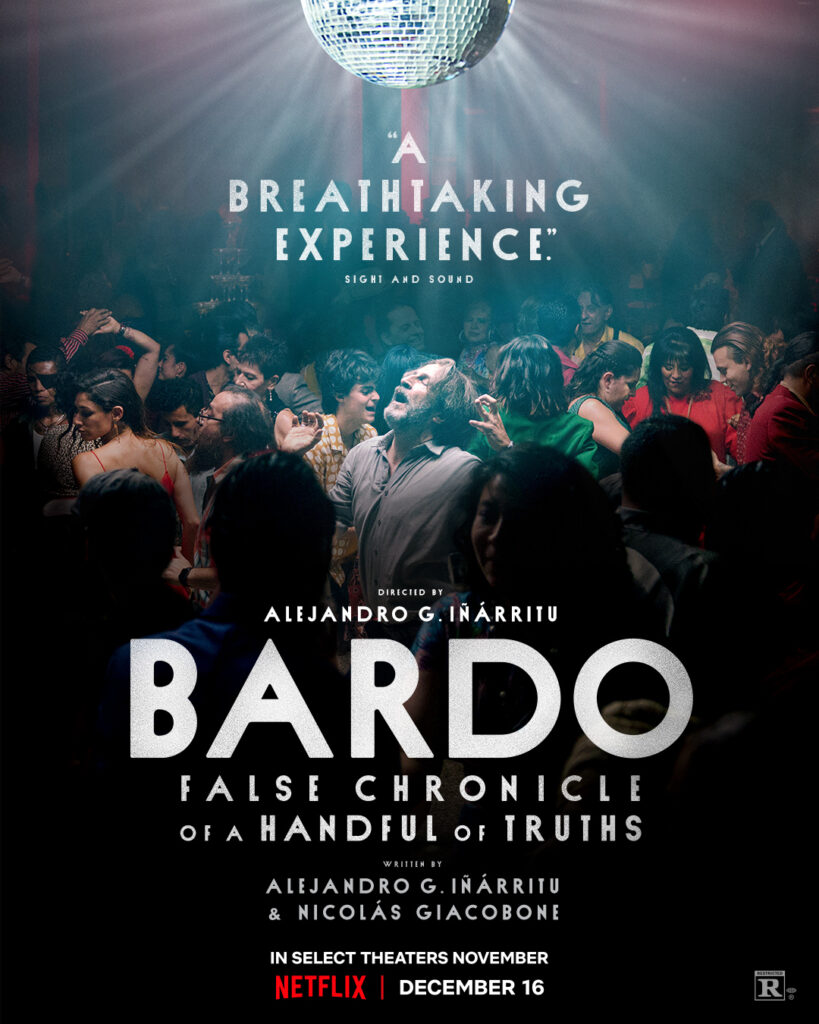
After I watched Birdman in 2014, I became an instant Iñárritu fan. I went back and watched his older works and though I was less impressed by The Revenant (the film he made after Birdman which felt very much like a film designed to give Leonardo DiCaprio an Oscar—which it did—since Leo didn’t get one for The Wolf of Wall Street), I was thrilled to learn Iñárritu had made another feature film after a seven year hiatus. And, holaaaay, what a film. An introspective, magical, political, celebratory, mournful, absurd, intimately lonely and altogether communal, masterpiece. I liked everything about this film and wept twice while I watched it. Once in the way when tear suddenly burst forth from you with an audible cry and you gasp and swallow them and once in the hard, drawn out, ugly crying way that you cry when you know tears are medicine. This is Iñárritu at his finest and, at his finest, he is sui generis. Watch this film. You won’t regret it.
3. Jones, Lee Haven. Gwledd/The Feast (2021).
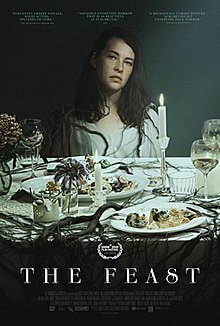
If you think this Welsh horror movie is just another played-out version of a ghost story (surveyors looking for ore/oil disrupt a part of the land that should not be disturbed and end up releasing a female spirit who seeks vengeance on them), you would be mistaken. If you know anything about the history of Wales and the ways in which the British conquered, colonized, and devastated it, and the ways in which the Welsh have continued to resist this over the last 800 years, the fact that the entire movie dialogue is in Welsh should tip the viewer off to the fact that something more is going on here.
I think Gwledd is actually a thoroughgoing criticism of British colonization and the transformation of land into a commodity that can be owned and destroyed to generate profit. It shows what happens to people when they become colonial subjects (in the Foucauldian sense) and shift from a land-based values system to a money-based values system. People become filled with an insatiable thirst, growing richer and richer, destroying more and more of what used to be, until ultimately they devour their own children (who are, themselves, either completely alienated from the land or already actively involved in all the worst forms of rapacious violence) and destroy their own lives. This is a warning to colonized peoples: if you adopt the ideology, values, economics, and practices of the colonizers, you are heading for a very gorey and very gooey end.
4. Avery, Julius. The Pope’s Exorcist (2023).

Given the contemporary resurgence of various fascisms and other movements committed to White supremacy, conquest, and smarmy, sneering, self-righteous brutality, the Roman Catholic Church probably feels like it has another shot at mass popularity. The Pope’s Exorcist plays like the kind of propaganda film the Vatican would produce in order to start getting back out there again (and it’s based on the various memoirs of real-life Catholic Exorcist Number One, Gabriele Amorth). But like most blatant propaganda pieces, it fails to offer anything that will appeal to the unconverted (even taken as a horror film qua horror film, within the demon possession subgenre, it felt played-out and cliché). Along the way, it pushes some outrageous ideas. For example, it claims that the Catholic Inquisition was the result of a demon possessing the Grand Inquisitor in order to incite violence and harm the church—turns out the Catholic church and not the women the Catholics burned to death was the true victim of the Inquisition! Remarkable. But its most offensive suggestion is that Roman Catholic Priests are actually self-sacrificing heroes who will go to any length to prevent children from experiencing harm. It is this pretense that most vividly reminds the viewer that this is a work of fiction—and a shitty work of fiction at that. Let the gods do as the gods will, for us mortals let there be no redemption for unrepentant, perpetual abusers and, for the love of all that’s holy, let’s not create works of art that valorise those abusers and present them as the very opposite of what they are. Because fiction or not, I suspect wannabe fascists everywhere will remember, “oh yeah, the Vatican was doing this holy war things better than us for centuries, let’s join forces!” Unless, of course, they are of the neo-pagan, eco-fascist variety. In that case, hopefully those fascists will fight the Evangelical-Roman Catholic Christo-fascist alliance since they colonized European peoples with a foreign faith and maybe the various fascists will just destroy each other. Or maybe not. The Night of the Long Knives didn’t work out well in the end for anti-fascists… Anyway… I’m kind of off topic now but this movie sucked hard so it’s not really worth talking about.
5. Cianfrance, Derek. Blue Valentine (2010).
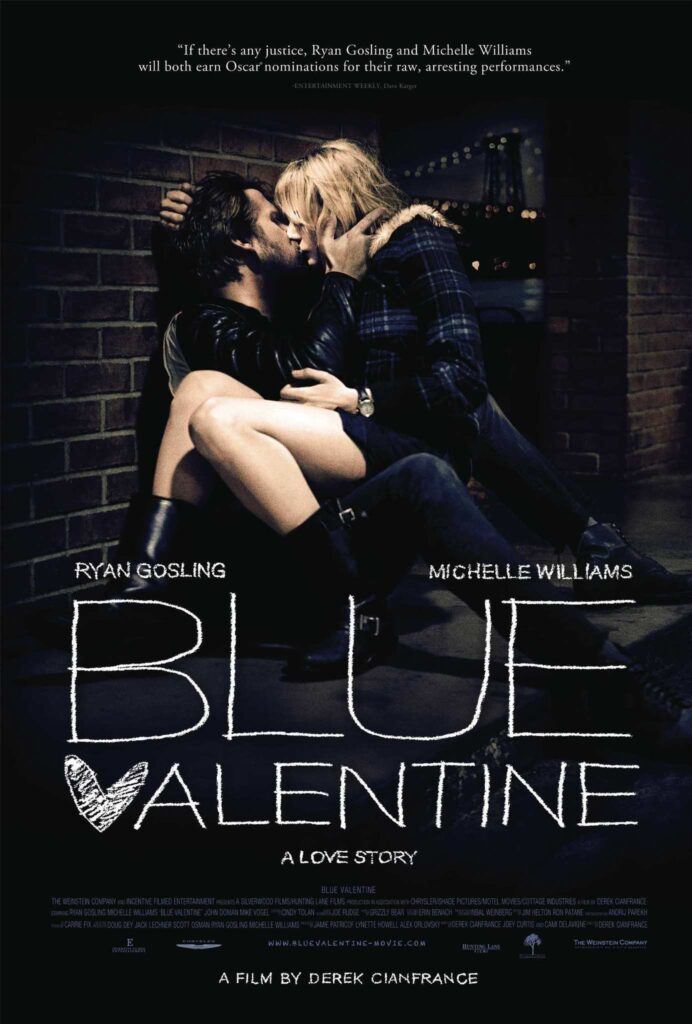
I’m not sure that I can think of another movie that captures that devastation of heartbreak as well as this one. Of course, there are many kinds of devastation—Lars von Trier’s Antichrist (2009) is a devastating reflection on the death of a child (although you can skip everything after the first five minutes—and, of course, there is the heartbreak of the death of a life partner, as documented in the first five minutes of Disney’s Up [2009]), and I think Gaspar Noé intends to break his audience’s heart with every film he makes. But this is a very different kind of devastation. Noé wants to make so much ugliness you forget beauty, so much violence that you forget peace, so much sickness that you forget how to be well. Noé wants to rip your heart out, spit on it, and make you believe that you were a fool to think you ever had a beating heart.
But the heartbreak wrought by Cianfrance is different. It is the heartbreak of anyone who has loved deeply, without hesitation, delightedly, and irrevocably who learns that, for no good reason, love is not enough. This is not because of death (we all know, as much as we wish to deny it, that death comes for us all), but because someone can fall out of love with us—not because we are cruel, not because we have been unkind, not because we have treated them poorly, but because of a thousand million little reasons that (from the perspective of the lover left behind) don’t seem to add up to anything close to an insurmountable obstacle. This is about the saddest thing that any lover can learn. It is an almost unassimilable thought. Total nonsense… and yet it persists, it exists, and the loved one will not return, the lover will love you no more, and what you thought is, is not, and will never be again.
The strength of Blue Valentine is the way in which Cianfrance shows (instead of tells) all of this. When the lovers fall in love, we fall in love with their love. When they hurt and find each other, we hurt and hope we them. When they experience the drudgery and grind of daily life, day-to-day, week-to-week, month-to-month, year-to-year, we know what it is to want to love well in the midst of that grind. When one drifts and the other doesn’t, we know that, too (perhaps even both sides of it). When one is broken-hearted by being the one to leave, and the other is broken-hearted by being the one left, and the child is broken-hearted and doesn’t know why, we also know these forms of heartbreak. We have experienced them. We have borne witness to them. We have been complicit in them and we have been subjected to them against our will.
But there are no heroes or villains here. The one who leaves is not a villain for leaving. And the one who is left is not a hero for wanting the other to stay. The grind of life in a life-stealing culture, changes us in ways we cannot anticipate and, once we have changed, what was once life-giving to us can become death-dealing. Sometimes we must flee lovers who love us well so that we can live. And sometimes loving well means accepting the devastation of being left.
The friend who suggested I watch this movie gave me a content warning. Not because of violence but because of the ways in which it can resurrect emotional trauma. I don’t think any movie has more powerfully reminded me of my various heartbreaks. Content warning, indeed!
DOCUMENTARIES
1. Cooley, Mark G., and Derek Ellis. Fighting Indians! (2021).
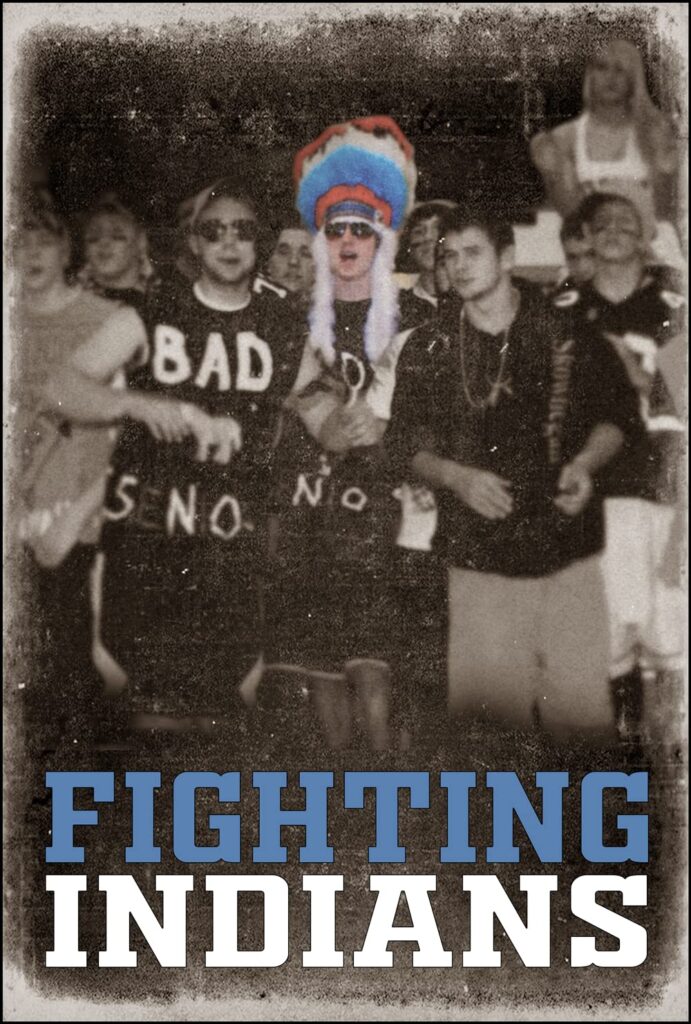
In 2019, the State of Maine passed a law banning the usage of Native American-themed mascots in all public schools. An almost entirely White high-school in the small town of Skowhegan was the last school to accept this and fought desperately against abandoning their “Fighting Indians” brand. Mark G. Cooley and Derek Ellis do a good job of contextualizing what this is all about. Engaging in interviews with Elders, historians, and members of Native youth councils, they break down why Indigenous peoples don’t want to be reduced to caricatures and mascots for White people (a point that is overwhelming obvious to the Black Panthers and other racialized peeps who engage in solidarity actions with Indigenous people but apparently impossible to understand for a lot of White people who get offended that other people get offended when they act like racist White supremacists even though they self-identify as tolerant).
But, to put a spin on a popular saying penned by Erich Segal, Whiteness means never having to say you’re sorry, and the ways in which the (large number) of Whites defending racist mascots resist acknowledging the past and present presence of genocidal settler colonialism and White supremacy, is truly pathological. Which is not to say that the Whites who defend the racist mascots are, in some way, more ill than the average White person. Far from it. It seems to me, that they simply reveal a core component of the pathologies that accompany Whiteness qua Whiteness (which, by the way, is part of the reason why decolonization is actually a liberatory process for both the colonized and the colonizer—in the context of colonization, the colonized are reduced to the status of the subhuman, but the colonizers becomes twisted into the status of the monstrous and so decolonization restores the possibility of uncorrupted humanity to both parties).
A thoughtful and well-done documentary that doesn’t feel compelled to put a veneer of hope onto hard realities. Is “reconciliation” possible? That’s hard to say. Is it desirable? Depends what you mean by it and it depends who you ask. This shit is hard to work out. Cooley and Ellis do a fine job of demonstrating that.
2. Webster, Justin. I Will Be Murdered (2013).
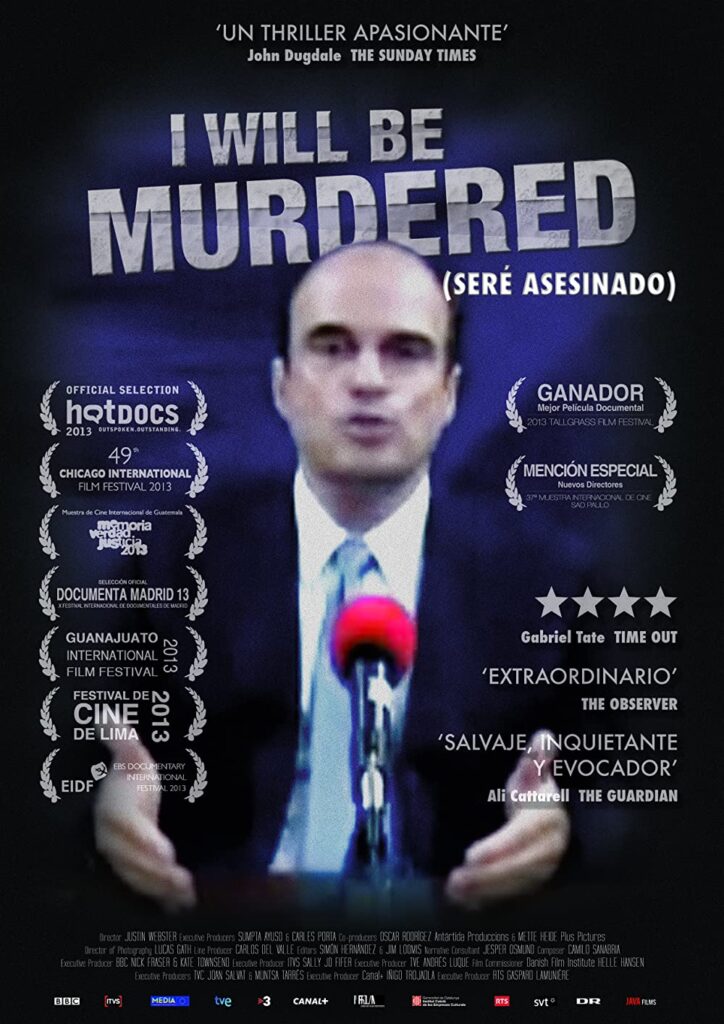
In better hands, the story Justin Webster tells in I Will Be Murdered, could have been the most mind-blowing, unexpected plot twist documentary ever made. The current title-holder, imo, is Bart Layton’s 2012 documentary, The Imposter. I Will Be Murdered tells a story that could have been The Imposter but on a national stage fraught with corrupt politicians, drug cartels, police-based death squads, and a ruthless economic oligarchy, in a city where nobody’s hands are clean, but Webster just isn’t up to the task. This story, and its jaw-dropping “big reveal” are not presented or framed well so that anyone who knows anything at all about Guatemala is bound to ask, “Really?? But what about [lists 6 other possible interpretations that Webster does not address well in the documentary]?” It’s too bad because this really is one helluva story. I am deliberately vague on the details so as not to provide spoilers, but this story in the New Yorker does a much better job of contextualizing the entire situation: https://www.newyorker.com/magazine/2011/04/04/a-murder-foretold (SPOILERS ALERT!). To be honest, I’m still not entirely sure that I believe it.